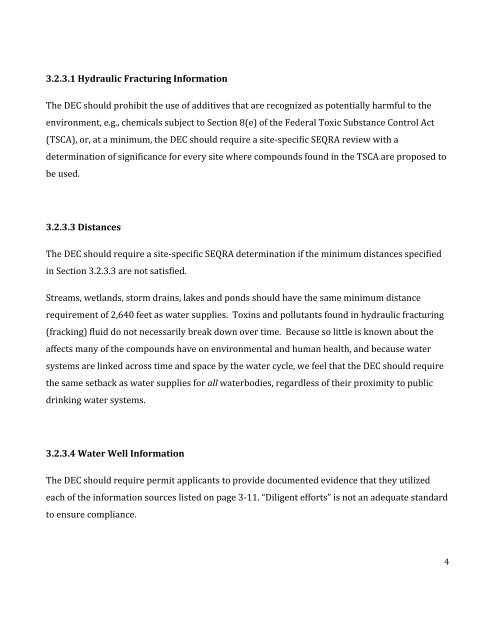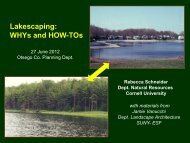file. - Otsego County Conservation Association
file. - Otsego County Conservation Association
file. - Otsego County Conservation Association
You also want an ePaper? Increase the reach of your titles
YUMPU automatically turns print PDFs into web optimized ePapers that Google loves.
3.2.3.1 Hydraulic Fracturing Information<br />
The DEC should prohibit the use of additives that are recognized as potentially harmful to the<br />
environment, e.g., chemicals subject to Section 8(e) of the Federal Toxic Substance Control Act<br />
(TSCA), or, at a minimum, the DEC should require a site-specific SEQRA review with a<br />
determination of significance for every site where compounds found in the TSCA are proposed to<br />
be used.<br />
3.2.3.3 Distances<br />
The DEC should require a site-specific SEQRA determination if the minimum distances specified<br />
in Section 3.2.3.3 are not satisfied.<br />
Streams, wetlands, storm drains, lakes and ponds should have the same minimum distance<br />
requirement of 2,640 feet as water supplies. Toxins and pollutants found in hydraulic fracturing<br />
(fracking) fluid do not necessarily break down over time. Because so little is known about the<br />
affects many of the compounds have on environmental and human health, and because water<br />
systems are linked across time and space by the water cycle, we feel that the DEC should require<br />
the same setback as water supplies for all waterbodies, regardless of their proximity to public<br />
drinking water systems.<br />
3.2.3.4 Water Well Information<br />
The DEC should require permit applicants to provide documented evidence that they utilized<br />
each of the information sources listed on page 3-11. “Diligent efforts” is not an adequate standard<br />
to ensure compliance.<br />
4




